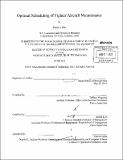| dc.contributor.advisor | Thomas Magnanti and Retsef Levi. | en_US |
| dc.contributor.author | Cho, Philip Y | en_US |
| dc.contributor.other | Massachusetts Institute of Technology. Operations Research Center. | en_US |
| dc.date.accessioned | 2011-12-19T18:49:37Z | |
| dc.date.available | 2011-12-19T18:49:37Z | |
| dc.date.copyright | 2011 | en_US |
| dc.date.issued | 2011 | en_US |
| dc.identifier.uri | http://hdl.handle.net/1721.1/67773 | |
| dc.description | Thesis (S.M.)--Massachusetts Institute of Technology, Sloan School of Management, Operations Research Center, 2011. | en_US |
| dc.description | Cataloged from PDF version of thesis. | en_US |
| dc.description | Includes bibliographical references (p. 106). | en_US |
| dc.description.abstract | The effective scheduling of fighter aircraft maintenance in the Air Force is crucial to overall mission accomplishment. An effective maintenance scheduling policy maximizes the use of maintenance resources and aircraft availability. Currently, maintenance scheduling is a time consuming process that is carried out by airmen whose sole responsibility is to manually generate a maintenance schedule that balances maintenance requirements and flying requirements. In this thesis, we seek to represent the maintenance scheduling process using a mathematical model that ultimately generates an optimal maintenance schedule. First, we address the scheduling of phase maintenance, the most significant preventative maintenance action, for fighter aircraft. We use a mixed integer program (MIP) to model the phase maintenance scheduling process. The MIP generates a daily maintenance and flying schedule that ensures that the maintenance workload is evenly distributed across the planning horizon. We find that the computational performance of the MIP formulation is less than desirable for large instances of real-world data. Motivated by the need for improved computational performance, we develop an alternative formulation that disaggregates the original MIP into two subproblems that are solved sequentially. The two-stage formulation of the phase maintenance scheduling problem has significantly better computational performance while generating a feasible daily maintenance and flying schedule. We then address the maintenance scheduling process that is unique to aircraft with low-observable (LO) capabilities. The LO capabilities of an aircraft degrade over time according to a stochastic process and require continuous maintenance attention. We show that the characteristics of the LO maintenance process allow it to be modeled as a variant of the mulitarmed bandit (MAB) problem. We then present a variant of the heuristic proposed by Whittle that has been shown to provide near optimal solutions for MAB problems. Applying Whittle's heuristic to the LO maintenance scheduling problem, we generate a simple index policy that can be used to schedule aircraft for LO maintenance. We then compare the index policy to alternate policies and show by simulation that the index policy leads to relatively better fully mission capable (FMC) rates, a common measure of overall fleet health. | en_US |
| dc.description.statementofresponsibility | by Philip Y Cho. | en_US |
| dc.format.extent | 106 p. | en_US |
| dc.language.iso | eng | en_US |
| dc.publisher | Massachusetts Institute of Technology | en_US |
| dc.rights | M.I.T. theses are protected by
copyright. They may be viewed from this source for any purpose, but
reproduction or distribution in any format is prohibited without written
permission. See provided URL for inquiries about permission. | en_US |
| dc.rights.uri | http://dspace.mit.edu/handle/1721.1/7582 | en_US |
| dc.subject | Operations Research Center. | en_US |
| dc.title | Optimal scheduling of fighter aircraft maintenance | en_US |
| dc.title.alternative | Optimal scheduling of fighter aircraft maintenance in the Air Force | en_US |
| dc.type | Thesis | en_US |
| dc.description.degree | S.M. | en_US |
| dc.contributor.department | Massachusetts Institute of Technology. Operations Research Center | |
| dc.contributor.department | Sloan School of Management | |
| dc.identifier.oclc | 767528895 | en_US |
